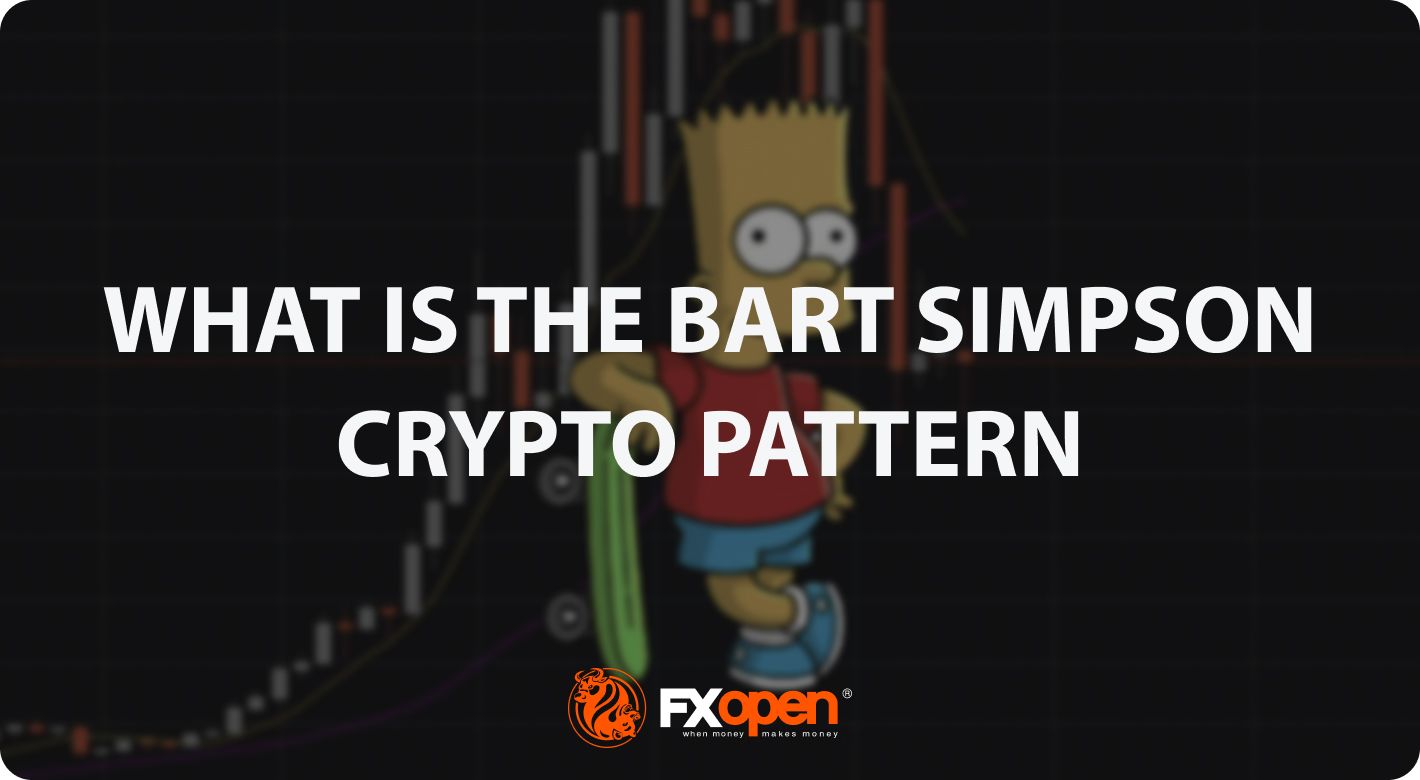FXOpen

Avid cryptocurrency traders constantly scrutinise price charts in search of different unique and intriguing formations. A Bart Simpson trading pattern is one of them. In this FXOpen article, we will delve into the Bart setup, exploring its characteristics and significance in the realm of cryptocurrency trading.
What Is the Bart Pattern?
The Bart Simpson setup is named after the popular cartoon character Bart Simpson due to its distinct shape that resembles the character’s hair. It’s a reversal formation that appears on short-term timeframes and it is characterised by a significant surge/plunge in the price that is followed by a consolidation and a return of the price to the previous levels.
Is the Bart pattern bullish or bearish? It includes bullish and bearish formations, which signal potential upward or downward price movements, respectively.
Bearish Bart
The bearish Bart Simpson chart pattern occurs when the price of a cryptocurrency witnesses a rapid and substantial increase, followed by a consolidation and a sudden and sharp decline. This forms a shape that resembles the head and spiky hair of Bart Simpson. The formation suggests that the initial surge may have been driven by speculative buying or market manipulation, and the subsequent decline indicates a possible shift towards a bearish trend.
Bullish Bart
The bullish or inverse Bart Simpson pattern typically occurs when the price of a cryptocurrency experiences a sudden and sharp decline, followed by a consolidation and a quick and significant recovery. On the chart, this forms a shape that mirrors Bart Simpson's head. The setup suggests that the initial decline might have been due to panic selling or market manipulation, and the subsequent recovery indicates renewed buying interest, potentially leading to a bullish trend.
How to Spot the Bart Pattern on the Chart
Spotting the Bart Simpson pattern on a crypto price chart requires the careful observation of specific characteristics. Here are the steps for identifying it:
- Familiarise Yourself with the Setup: Before attempting to spot the Bart Pattern, make sure you understand its structure. It consists of three key elements: a sharp price movement (in either direction), a consolidation that resembles Bart’s hair, and a quick reversal to the initial point that completes the head of the cartoon character.
- Choose a Suitable Chart: Select a cryptocurrency of interest and the timeframe for analysis. The setup is most common for short-term periods, including minute and hourly charts.
Note: although the Bart pattern is more common for the crypto market, it can be identified on charts of different assets. For example, you can spot a Bart Simpson stock pattern or Bart Simpson in the forex chart. - Observe Price Movement: Look for a rapid and substantial price movement. In a bullish Bart, this will be a sharp decline, while in a bearish Bart, it will be a rapid surge. This movement is usually caused by significant market activity due to unexpected news.
- Identify the Reversal: After the initial sharp movement, watch for a consolidation and quick and substantial reversal in the opposite direction. This is what forms the spiky hair of Bart Simpson and finishes the setup. In a bullish Bart, the price will recover rapidly from the decline, and in a bearish Bart, the price will sharply decline after the initial surge.
- Draw Trendlines: To better visualise the formation, you can draw trendlines connecting the key points. For a bullish Bart, you may draw a horizontal line connecting the high before the plunge and an equal high after the surge. For a bearish Bart, you can draw a line connecting a low before the surge and an equal low after the plunge.
How to Trade the Bart Pattern
Trading the formation requires cautious analysis and risk management. Here are some essential considerations:
- Entry: Traders might consider entering a position after the consolidation period is completed and shows signs of either bullish or bearish reversal. Waiting for confirmation, such as candlestick or chart patterns, helps reduce the risk of false signals.
- Take Profit: Setting a realistic profit target is crucial. This could be based on historical price levels, Fibonacci extensions, or other technical indicators such as support/resistance levels.
- Stop Loss: Implementing a stop-loss order is vital to limit potential losses if the trade goes against expectations. Placing the stop loss below the pattern's bottom (for bullish Bart) or above the pattern's top (for bearish Bart) may help manage risk.
There is a bullish Bart Simpson on a graph of BTCUSD on the TickTrader platform. The trader enters a long position when the price breaks above the setup's resistance drawn through the starting and ending points of the pattern. Their take profit is located at the next resistance level with a stop-loss placed below the pattern’s consolidation area.
Final Thoughts
As with any technical analysis tool, it is essential not to rely solely on the pattern but to use it in conjunction with other indicators and analysis methods for a well-rounded trading strategy. Traders should exercise caution, conduct thorough research, and practice risk management while incorporating the formation into their cryptocurrency trading activities. As you develop a stronghold of the formation, you may open an FXOpen account and trade the setup with low spreads and ultra-fast executions.
At FXOpen UK and FXOpen AU, Cryptocurrency CFDs are only available for trading by those clients categorised as Professional clients under FCA Rules and Professional clients under ASIC Rules, respectively. They are not available for trading by Retail clients.
This article represents the opinion of the Companies operating under the FXOpen brand only. It is not to be construed as an offer, solicitation, or recommendation with respect to products and services provided by the Companies operating under the FXOpen brand, nor is it to be considered financial advice.
Stay ahead of the market!
Subscribe now to our mailing list and receive the latest market news and insights delivered directly to your inbox.








